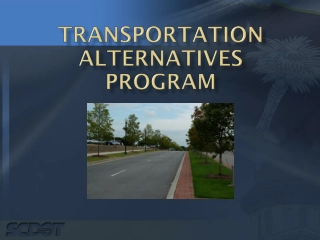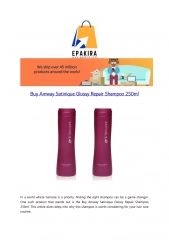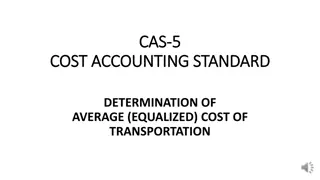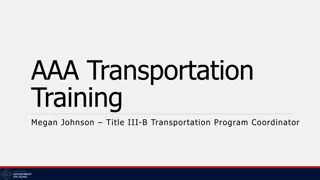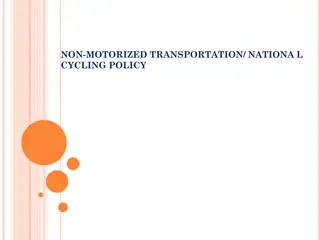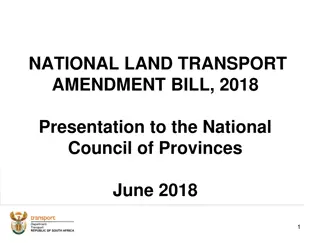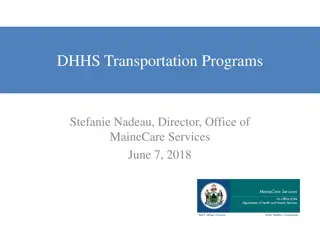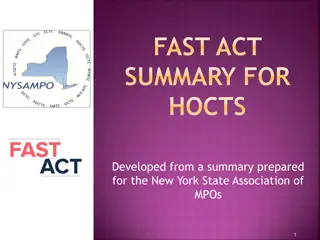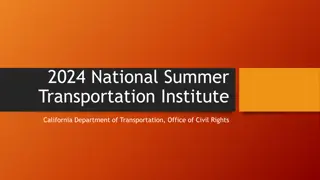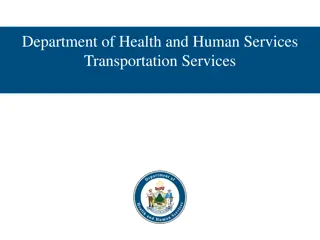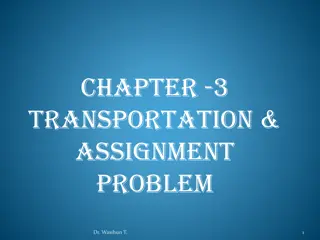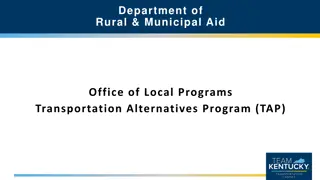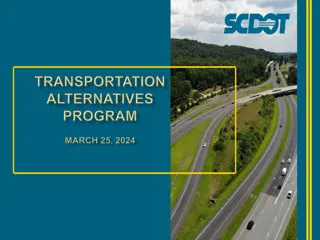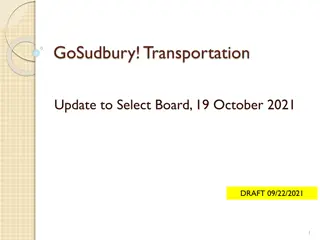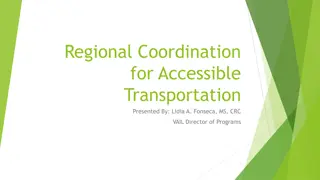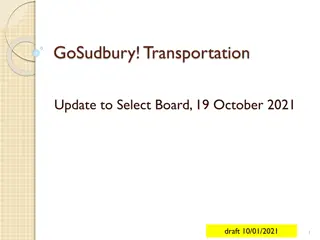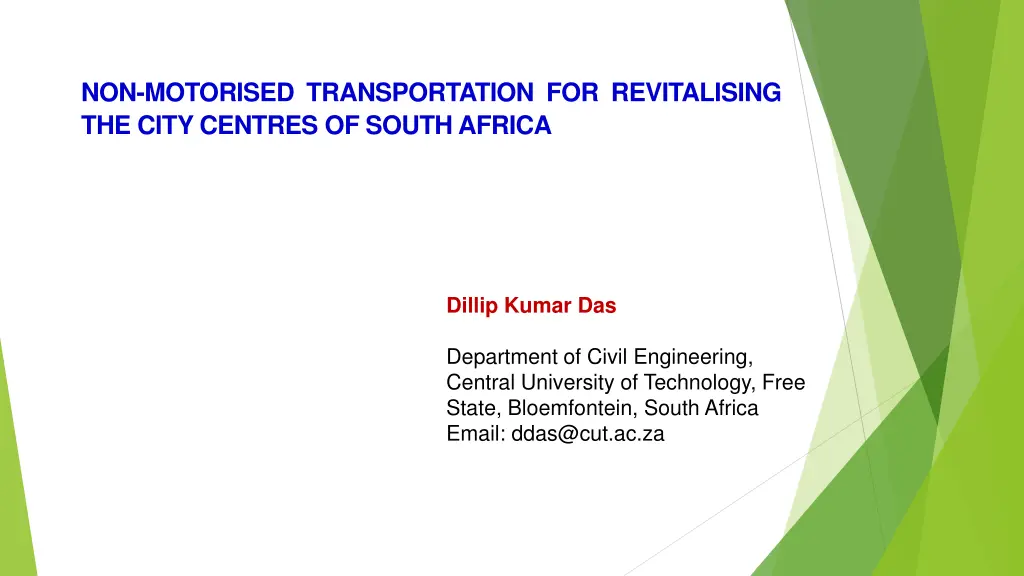
Non-Motorised Transportation for Revitalising City Centres in South Africa
Explore the challenges of non-motorised transportation in South African cities and how it can lead to revitalisation of CBDs. The study focuses on the importance of pedestrianization and bicycling in enhancing accessibility, safety, and community engagement within city centres.
Download Presentation

Please find below an Image/Link to download the presentation.
The content on the website is provided AS IS for your information and personal use only. It may not be sold, licensed, or shared on other websites without obtaining consent from the author. If you encounter any issues during the download, it is possible that the publisher has removed the file from their server.
You are allowed to download the files provided on this website for personal or commercial use, subject to the condition that they are used lawfully. All files are the property of their respective owners.
The content on the website is provided AS IS for your information and personal use only. It may not be sold, licensed, or shared on other websites without obtaining consent from the author.
E N D
Presentation Transcript
NON-MOTORISED TRANSPORTATION FOR REVITALISING THE CITY CENTRES OF SOUTH AFRICA Dillip Kumar Das Department of Civil Engineering, Central University of Technology, Free State, Bloemfontein, South Africa Email: ddas@cut.ac.za
INTRODUCTION CBDs which were once nerve centers of the cites are now becoming more or less prohibited areas for a large segment of the population The major challenges of such denegation are argued to be poor maintenance of the infrastructure and services, occurrence of crime, fear for safety and lack of local accessibility by non-motorised transportation system such as pedestrianization and bicycling
INTRODUCTION Lack of non-motorised accessibility and predominant use of vehicular modes to access the CBDs restrict the access to important public, social, cultural and recreational elements. consequently limit the use of public places, recreational activities, and community interaction; as a result, the vitality of the CBDs is dwindling So, there is a need to examine the status of the non-motorised transportation system in the CBDs of South African cites and how it can enable revitalisation of these city centres.
OBJECTIVE The study examines the challenges of non-motorised transportation in the cities of South Africa and how the use of non-motorised transportation can revitalise the city centres
STUDY AREA Bloemfontein, Free State, South Africa Morphologically the major part of the city constitutes low to medium density areas and low rise buildings. The CBD is very compact and significantly dense. The distance of the CBD from the various suburbs range between minimum of 0.5 kilometre to a maximum 15 kilometres. However, the majority of the suburbs are within an average distance of 0.5 to 5 kilometres, which are agued to be accessible by non-motorised transportation. Road Transportation system and accessibility The CBD is accessible by a paved road network system comprising of arterial roads, local roads and streets, which are predominantly accessible by motorised vehicles. The roads are mostly of one-way system. On road parking facilities are available on most of the roads and streets. Paved footpaths are available adjacent to majority of the roads, walking by people is not largely observed. Bicycling facilities are non-existent in the area. The CBD is observed to face large scale parking challenges, congestions, vehicular accidents and air pollution because of the large scale vehicular movement in the area.
STUDY AREA Bloemfontein, Free State, South Africa Vital parameters Population: 500000 (370% growth in last 65 years, 11th fastest) Area City Metro 6,283.99 km2 236.17 km2 The average population density of the city is about 1730 persons per square kilometre. However, the CBD and its adjacent areas are of high density (ranging between 2000- 3000 persons/ square kilometre). The suburbs at the far North and far South are the low density areas (<1000 persons per square kilometre). The rest of the suburbs are of medium density areas (1000-2000 persons per square kilometre).
RESEARCH METHOD A survey research method was used to conduct the study. Data was collected by conducting two types of survey such as physical survey and perception survey of the people working, and living in- and visiting to the city centre The physical survey was conducted to collect data on the spatial, and accessibility attributes and availability of non-motorised transportation related facilities in the CBD. The survey was conducted at certain specific areas of the CBD and major roads Perception survey was conducted to Collect data on the perception of accessibility of the CBD, status of pedestrianization, bicycling, social and physical- spatial challenges deterring the use of non-motorised transportation system, plausible strategies and demands for infrastructure were collected from the people living, and working in- and visiting the CBD. The data was collected by conducting a perception survey by using a pre-tested questionnaire through a random sampling process
RESEARCH METHOD The perceptions were collected by using a five point Likert scale ranging between 1 and 5, 1 indicates not important, 2 indicates somewhat important, 3 indicates important, 4 is very important and 5 indicates extremely important Sample size: 215 Analysis Standard Deviation (SD) analysis were conducted to check the consistency of the data Cronbach test was conducted to check the reliability of the data set. The perceptions on the various variables and strategies and demands of infrastructure were evaluated based on the mean score of the perceptions on the Likert scale or in other words developing a Perception Index (PI) A PI more than or equal to 3 (PI 3) was considered as important, for assessing the conditions of accessibility, availability of non- motorised infrastructure, challenges because of lack of non-motorised transportation, strategies and demands for various non-motorised infrastructure.
RESEARCH METHOD Significance tests such as z test was conducted to explore the plausible linkages between non-motorised transportation attributes such as pedestrianization and bicycling facilities with the vitality attributes of the city centres such as use of central pubic space, community interaction, reduction in crimes or fear of crimes. A z probability scores more than 0.5 (z>0.5) is considered that majority of the people agree with the perceptions on the variables and deemed to have statistical significance
RESULTS AND DISCUSSIONS Accessibility of the CBD Accessibility infrastructure Roads Designated Bus/ Taxi Lanes Parking facilities for Cars/ Buses Parking facilities for motor bikes Pedestrian walkways 2.85 Bicycle lanes Bus stops Taxi stops Elevated (overpass)/ underground Road crossing elements (underpass) Perception index (PI) 4.15 NA SD z values z probability 0.44 NA 2.61 NA 0.995 NA The infrastructure for vehicular access such as roads, bus/ taxi stops and parking facilities for cars/ buses/ taxis are available But infrastructure for accessing by non-motorised transportation in the CBD is a challenge. 0.904 3.42 0.32 1.31 NA NA NA NA 0.35 0 0.38 0.42 -0.43 0.333 NA 3.37 3.28 0.97 0.67 0.834 0.748 NA
RESULTS AND DISCUSSIONS Mode of accessibility to the CBD Accessibility modes Percepti on index (PI) SD z values z probability Vehicular modes such as privately owned vehicles (is the predominant mode of accessibility in the CBD. Although, public transportation and privately owned motor bikes do exist they are not predominantly used to access the CBD by people. Similarly, although some people walk to access the CBD, it is not prevalent (PI= 2.56 and z probability is 0.203). The use of bicycles is similar to that of walking and is not largely observed. Vehicular Public transportation Privately owned vehicles (Cars) Privately owned vehicles (Motor Bikes) Non-motorised Bic-cycles Pedestrians 2.92 0.46 -0.174 0.432 3.87 0.36 2.42 0.992 1.67 0.52 -2.56 0.005 1.18 2.56 0.64 0.53 -2.84 -0.83 0.002 0.203
RESULTS AND DISCUSSIONS Availability of non-motorised transport infrastructure Pedestrian pathways and road crossings at junctions are available movement. The pedestrian pathways are available on both sides of the roads, which are generally found to be paved and have average width ranging between 1.0m to 1.5m. Traffic signal phases for walking are available for the crossing of the roads by the pedestrians. However, underpasses or overpasses for the crossing of the roads are not available in the CBD area. Medians and islands for pedestrian to wait (or take refuse) during the crossing that assist the pedestrian to cross the roads are only available on important roads and junctions respectively. Bicycle lanes are not available at all.. Infrastructure Pedestrian footpaths Availability Yes Condition/ attribute Available on both sides of the roads Paved Average Width 1.0m- 1.5m for pedestrian pathways/ No Bicycle ways (lanes) Road crossings at junctions Yes Provided as per the SADC traffic manual, 2012 No Available at important junctions. Overpass or under passes Traffic signal phases for walking Pedestrians difficulties to cross the road where pedestrian crossings provided. face are not Available on some roads Available junctions Available sporadically Medians at some Islands for pedestrians to wait or take refuse Facilities available Physically (disabled) road users On some places short distance ramps available in stead of stairs for are challenged
RESULTS AND DISCUSSIONS Challenges caused by vehicular access and non-availability of non-motorised transportation facilities Challenges Perceptio n index (PI) Congestion 3.72 0.52 1.38 0.916 Parking 3.86 0.56 1.53 0.937 Accidents 3.1 0.43 0.23 0.591 Lack of accessibility of public places (parks, central places) Lack of use of public places Poor Community interaction Commercial activities The predominant vehicular access and non- availability of non-motorised transportation facilities significantly interaction among the people and adequate use of the public places. SD z values Z probability hamper community The other challenges which were observed are congestion, non-availability of parking spaces, occurrence of accidents and lack of accessibility to public places (parks, and central places) However, commercial generally influenced by the lack of non- motorised transportation facilities and vehicular access. 3.64 0.62 1.03 0.848 4.12 0.61 1.83 0.966 activities are not 4.26 0.65 1.93 0.973 2.14 0.32 -2.68 0.0037 However, restriction of the vehicular movement in the CBD area including on the internal streets is not a favoured option.
RESULTS AND DISCUSSIONS Strategies for augmenting non-motorised transportation system Augmentation of public transportation system Augmentation of bicycling system ICT enabled public navigation system on the streets and Crime vigilance system are the three most important strategies which should be prioritised. There is a need for the linking of bicycling system with the public transportation system for seamless integration transportation with transportation facilities. The linking of the pedestrian walkways and bicycling lanes with the important public areas and places of interest such as parks, play grounds, civic services, business services such as banks, post offices, etc., and places of tourist interest will enable them to integrate with the transportation facilities and provide higher accessibility as well as improve community interaction Strategies Perceptio n index (PI) 2.76 SD z values z probabilit y 0.291 0.44 -0.54 Restrictions of Vehicular movement in the internal streets Off road parking system Augmentation transportation system Augmentation of Bi-cycling system Linking public bicycling system with transportation system Linking pathways and bi-cycling lanes with important public areas and interest ICT enabled navigation system on the streets and crime vigilance system 3.72 4.03 0.62 0.72 1.16 1.43 0.877 0.923 of public of public 3.92 0.73 1.26 0.896 the non-motorised 3.12 0.48 0.25 0.598 public 3.34 0.56 0.61 0.729 pedestrian places of 3.82 0.62 1.32 0.906 public
RESULTS AND DISCUSSIONS Demand for non-motorised transportation related facilities Facilities Perception index SD z values z probabilit y 0.956 Based infrastructures that are demanded by the people on priority are strengthening of the pedestrian walkways where available and creation of pedestrian walkways if not available Illuminating the roads and installation of crime vigilance system which are expected to augment the walking and bicycling without fear of crime or accidents. Creation of street side beautiful street scape and arboriculture (plants and gardens) Provision of sitting places on the street sides and central places Availability of bicycles and bicycle parking areas However, construction of overpasses and underpasses for pedestrians was not favoured by the respondents. on the strategies, the various 4.15 0.67 1.71 Pedestrian walk ways (strengthening creation as relevant) Bi-cycle lanes On demand b-cycles availability Bi-cycle areas Sitting facilities on the streets and public places Illumination Overpass underpasses pedestrians Installation of crime vigilance system Street scape design and arboriculture (gardens and plants) and 3.23 3.12 0.56 0.49 0.41 0.24 0.659 0.594 3.02 0.48 0.042 0.662 parking 3.18 0.42 0.43 0.666 3.53 2.16 0.62 0.56 0.85 -1.5 0.802 0.006 and for 3.42 0.72 0.58 0.719 3.45 0.82 0.55 0.708
CONCLUSIONS CBD of Bloemfontein has accessibility challenges with regards to non-motorised transportation although they are largely accessible by vehicular modes of transportation Some facilities for non-motorised transportation particularly for pedestrians are available, however, facilities for bicycling are totally non-existent The lack of non-motorised transportation has engendered several challenges that include poor community interaction among the people, inadequate use of the public places, occurrence of traffic congestion, non-availability of parking spaces, occurrence of accidents, and lack of accessibility to public places, although commercial activities are not significantly affected it is argued that the lack of access to- and use of public spaces, and lack of community interaction in addition to the accessibility challenges and fears of crime contribute to lessen the liveliness and vivacity of the CBDs
CONCLUSIONS Augmentation of non-motorised transportation system by improving pedestrian facilities, creating bicycle movement infrastructures, installing ICT enabled public navigation system on the streets and crime vigilance system, designing beautiful street scape and integrating them with public spaces, social activities and tourist attractions would enhance peoples movement in the CBD as well as enable higher community interaction and is envisaged to contribute to revitalise the city centres (CBDs) of South Africa
Thank you Prof DK Das Department of Civil Engineering Central University of Technology, Free State, South Africa Email: ddas@cut.ac.za Phone: 0848529260


